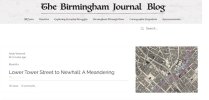I consider myself fortunate to not have experienced dreadful living conditions and poor sanitation. When you read Dickens thre are graphic descriptions of conditions of how some people had to live. No wonder diseases spread fast and immunity to fight off disease was poor. As early as 1836, Dickens captured the desperate nature of living and sanitary conditions for some unfortunate families in Sketches by Boz :
"Wretched houses with broken windows patched with rags and paper: every room let out to a different family, and in many instances to two or even three - fruit and ‘sweet-stuff’ manufacturers in the cellars, barbers and red-herring vendors in the front parlours, cobblers in the back; a bird-fancier in the first floor, three families on the second, starvation in the attics, Irishmen in the passage, a ‘musician’ in the front kitchen, and a charwoman and five hungry children in the back one - filth everywhere - a gutter before the houses and a drain behind - clothes drying and slops emptying, from the windows; girls of fourteen or fifteen, with matted hair, walking about barefoot, and in white great-coats, almost their only covering; boys of all ages, in coats of all sizes and no coats at all; men and women, in every variety of scanty and dirty apparel, lounging, scolding, drinking, smoking, squabbling, fighting, and swearing.”
This was about London, but it would have been typical of many families. Dickens did much to highlight the dire problem in the early 1800s. The worst of it all was it was an endless cycle, impossible to get off without proper intervention. Hence why slum clearance had to be part of the solution.





